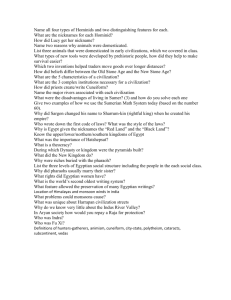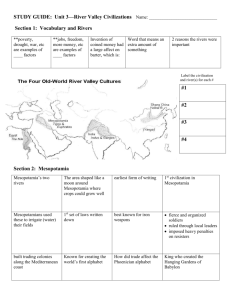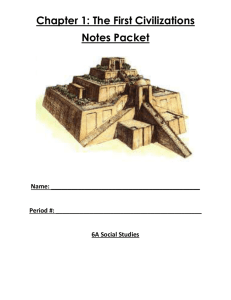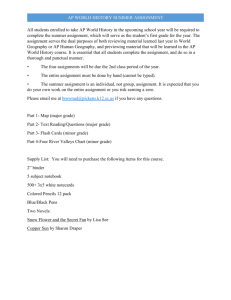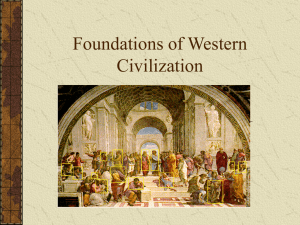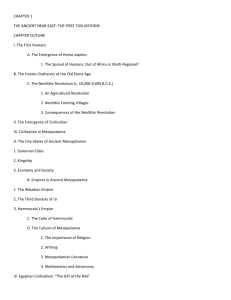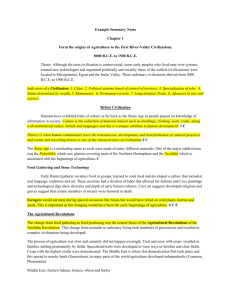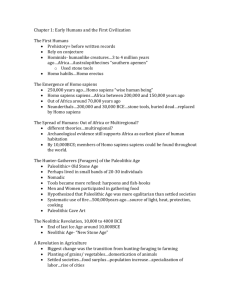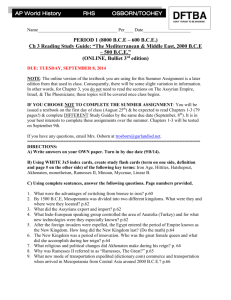File
advertisement
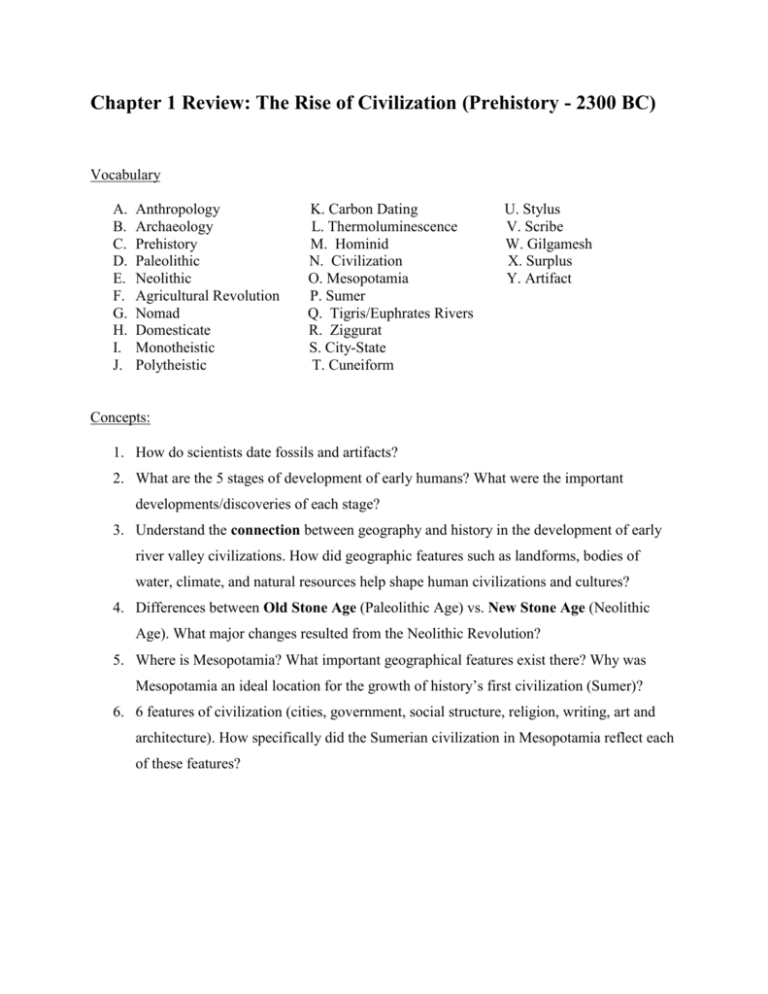
Chapter 1 Review: The Rise of Civilization (Prehistory - 2300 BC) Vocabulary A. B. C. D. E. F. G. H. I. J. Anthropology Archaeology Prehistory Paleolithic Neolithic Agricultural Revolution Nomad Domesticate Monotheistic Polytheistic K. Carbon Dating L. Thermoluminescence M. Hominid N. Civilization O. Mesopotamia P. Sumer Q. Tigris/Euphrates Rivers R. Ziggurat S. City-State T. Cuneiform U. Stylus V. Scribe W. Gilgamesh X. Surplus Y. Artifact Concepts: 1. How do scientists date fossils and artifacts? 2. What are the 5 stages of development of early humans? What were the important developments/discoveries of each stage? 3. Understand the connection between geography and history in the development of early river valley civilizations. How did geographic features such as landforms, bodies of water, climate, and natural resources help shape human civilizations and cultures? 4. Differences between Old Stone Age (Paleolithic Age) vs. New Stone Age (Neolithic Age). What major changes resulted from the Neolithic Revolution? 5. Where is Mesopotamia? What important geographical features exist there? Why was Mesopotamia an ideal location for the growth of history’s first civilization (Sumer)? 6. 6 features of civilization (cities, government, social structure, religion, writing, art and architecture). How specifically did the Sumerian civilization in Mesopotamia reflect each of these features? Chapter 2 Review – The Spread of Civilization Sections 1+2 only (pgs 22-31 in textbook) Instructions: Answer questions on a separate sheet of lined paper, staple and submit before your test on Thursday morning. Vocabulary A. B. C. D. E. F. G. H. I. J. K. L. M. Nile Delta King Menes Sir Arthur Evans Hieroglyphics Hieratic Script Pharaoh Osiris Myth Bureaucracy Dynasty Pyramids at Giza Great Pyramid of Khufu Crete Myth of Theseus and the Minotaur N. O. P. Q. R. S. T. U. V. W. X. Y. Z. Palace at Knossos Minoans Linear B (Minoan writing) Mummification Papyrus Reincarnation Phoenicians/Phoenicia Phoenician City States (Byblos, Tyre) Colonies/Colonization The Torah Monotheism Hebrew The Ten Commandments Concepts: 1. What was the significance of geography to Egypt’s development? (pg 22) 2. What were some of the accomplishments of Egypt’s Old Kingdom? (pg 23) 3. How was Egyptian society organized? (pg 25) 4. What were some of the cultural contributions of the ancient Egyptians? (pg 26) 5. What were the cultural and economic accomplishments of the Phoenicians? (pg 28) 6. What was the lasting influence of the Israelites? (pg 29) 7. Why do historians believe that the Minoan civilization was advanced? (pg 32) Chapter 3 Review – Early Empires of the Near East Vocab A. B. C. D. E. F. G. H. I. Akkad Sargon Empire Babylon Hammurabi’s Code Codify Stele Patriarchal Hyksos Invasion J. Chariots K. Amenhotep III L. Amenhotep IV (Akhenaten) M. Aten N. Amarna Period O. Hatshepsut P. Expeditions Sea Peoples Q. R. S. T. U. V. W. X. Assyrians Chaldeans Persians Cyrus the Great Darius Satrapies/Satraps Monarchy Zoroastrianism Concepts 1. What were the contributions of Sargon of Akkad? 2. What was the significance of Hammurabi’s codification of laws 3. What influence did the Hyksos have on Egypt’s Middle/New Kingdoms? 4. What were the accomplishments/changes imposed by the Pharaohs of Egypt’s New Kingdom? 5. What caused the downfall of Egypt’s New Kingdom? 6. What characterized the empire of the Assyrians? 7. What factors contributed to the success of the Persian Empire? How did their methods of ruling differ from those of the Assyrians? 8. What were the major characteristics of Persia’s religion, Zoroastrianism?

